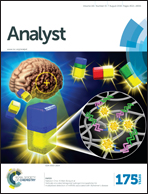Monitoring drug–lipid membrane interactions via a molecular rotor probe†
Abstract
Molecular rotors are fluorescent molecules with a viscosity-sensitive fluorescence quantum yield that are often used to measure viscosity changes in biological membranes. Herein, we report the use of a lipophilic molecular rotor probe to monitor the interactions between the local anesthetic tetracaine (TTC) and small unilamellar vesicles (SUVs) in a label-free manner. The probe was developed by modifying the fluorescent molecular rotor CCVJ with an amphiphilic anchor group that enables adequate integration of the rotor group into the hydrophobic core of lipid bilayers. The temperature-dependent profile of the quantum yield of the probe clearly exhibited the subtransition, pretransition and main phase transition of the lipid bilayers as drastic changes in the activation energies. The temperature-TTC phase diagrams were determined based on an Arrhenius fitting. The results show that TTC has a significant chain ordering effect on liquid-crystalline phase lipids compared to solid-gel phase lipids, especially subgel phase lipids. A TTC-induced interdigitated gel (LβI) phase appeared at the pretransition temperature. The LβI phase spread both its ends in a TTC-dependent fashion, and the low-temperature end merged to the subtransition at a TTC concentration of 25 mM. Adding cholesterol (CHOL) to the SUVs stabilizes the LβI phase and reduces the insertion of TTC into the bilayers. The paper demonstrates that our method is highly sensitive to the microenvironment of the lipid membrane, providing a facile and efficient new tool to study drug–membrane interactions. Also, molecular rotors may potentially be exploited as screen probes for drug development and analysis.


 Please wait while we load your content...
Please wait while we load your content...